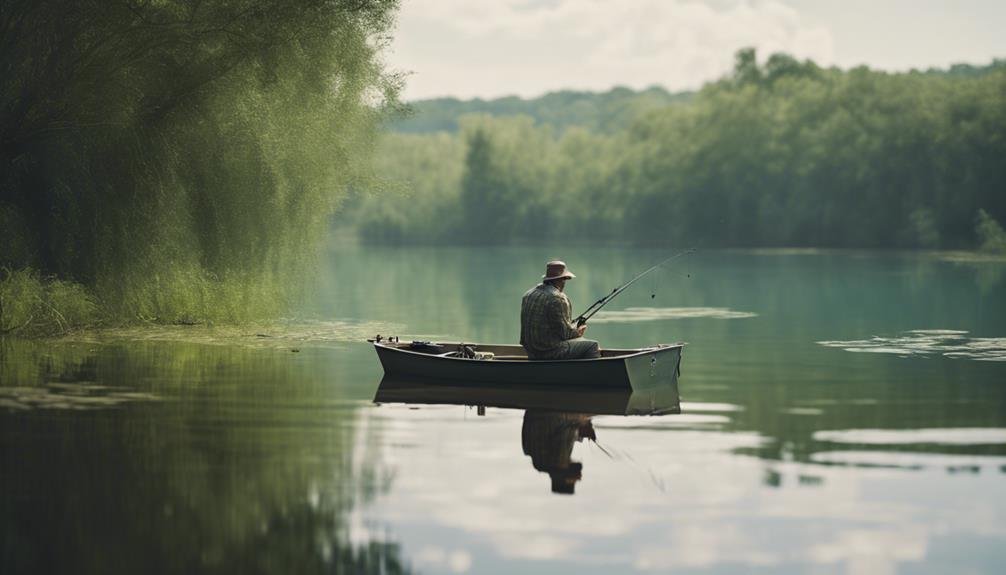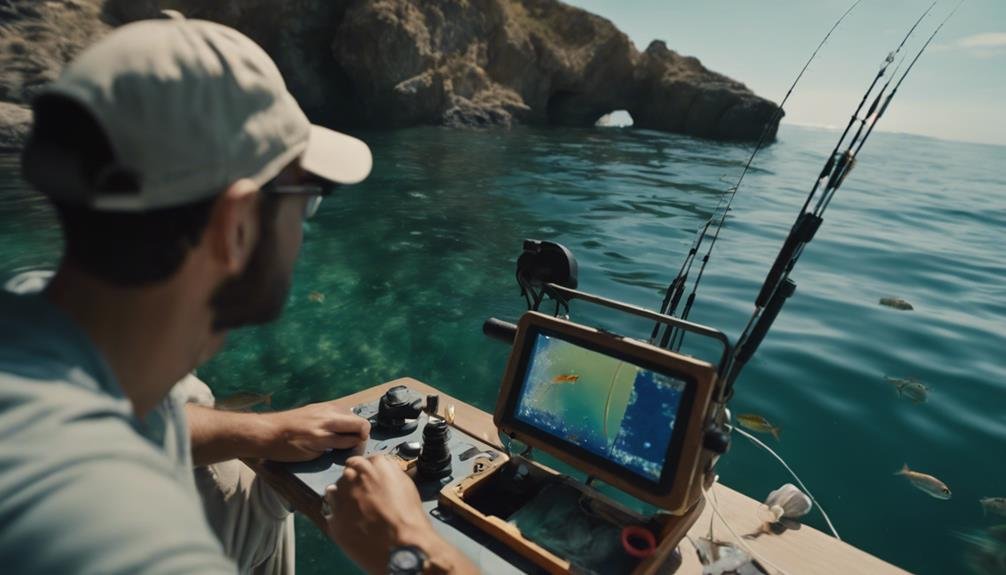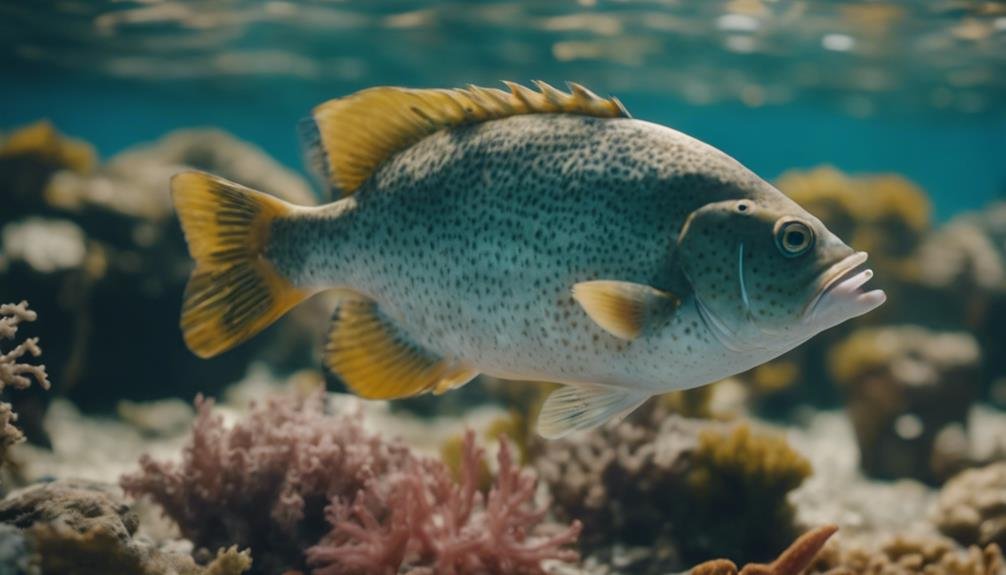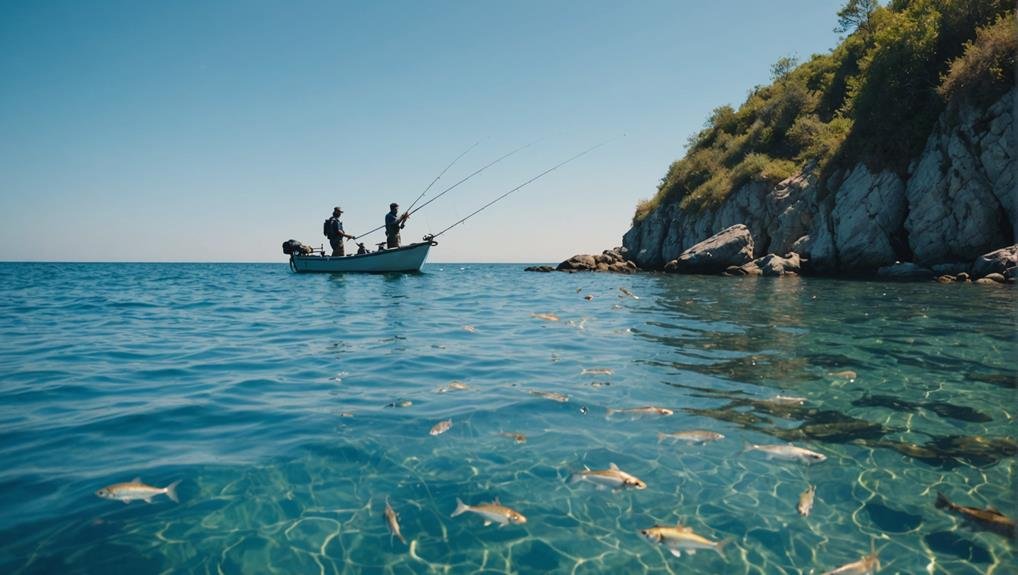When it comes to bottom fishing, you need to understand the basics to maximize your success on the water. This technique involves dropping a weighted hook to the bottom to target fish like snapper and grouper. You’ll want to gather essential gear, such as sinkers, hooks, and the right fishing line. Knowing which rigs to use, like sliding sinker rigs, can make a significant difference. But the key to mastering bottom fishing is adjusting your bait presentation based on the environment and the species you’re after. So, where do you begin?
Key Takeaways
- Use weighted hooks or lures to reach the bottom of the water column and target bottom-dwelling fish.
- Select the appropriate sinkers, like egg, bank, or pyramid, to keep the bait anchored on the bottom.
- Depending on the fishing environment, opt for strong fishing lines such as monofilament, braided, or fluorocarbon.
- Employ techniques like tightening, bottom bouncing, and jigging to present bait effectively and attract fish effectively.
- Target areas with underwater structures like reefs, rocks, and wrecks, where fish tend to congregate.
What Is Bottom Fishing

Bottom fishing involves lowering a weighted hook or lure to the bottom of the water column to target fish species. It’s a vital method practiced in both freshwater and saltwater environments, allowing you to catch a variety of fish, such as snapper, grouper, bass, and catfish.
The core of bottom fishing involves using a hook, line, sinkers, and bait to attract these bottom-dwelling fish.
Understanding the different bottom fishing techniques can greatly improve your success rate. Depending on the water conditions and the behavior of the fish you’re targeting, you can choose from various rigs, each designed to present your bait effectively.
For instance, a simple drop-shot rig might work well in calm waters, while a Carolina rig can be more effective in areas with strong currents.
It’s important to know how fish behave and where they’re likely to be found. They often congregate around structures like reefs, rocks, and wrecks. Your bait presentation should mimic these fish’s natural food sources, making your offering irresistible.
Essential Gear
To succeed in bottom fishing, you must gather essential gear like sinkers, hooks, and the right fishing line. Start by choosing the appropriate sinkers; egg, bank, and pyramid sinkers are all great options that help keep your bait on the bottom. Pyramid sinkers are especially effective in strong currents due to their shape.
Your fishing line is another vital piece of equipment. Monofilament lines are versatile and user-friendly, while braided lines offer superior strength and sensitivity. Fluorocarbon lines are nearly invisible underwater, making them ideal for wary game fish.
Circle hooks can greatly improve your catch rate, especially when targeting large game fish. These hooks are designed to minimize gut hooking, ensuring a higher survival rate for released fish.
When it comes to fishing rigs, you have several choices. Sliding sinker rigs allow your bait to move naturally, while spreader rigs and 3-way rigs provide different presentations to entice fish. Each rig has its advantages, so having a variety of rigs in your tackle box is beneficial.
Techniques and Strategies

Once you’ve gathered your essential gear, it’s time to master the techniques and strategies that will make your bottom fishing expeditions successful. One effective method is tightening, where you use enough weight to keep the bait on the bottom and detect fish strikes by watching your rod tip. Using live bait or cut bait can often yield much better results. Another technique is bottom bouncing, which involves moving the bait along the bottom to entice fish to bite.
Here’s a quick comparison of techniques and their uses:
| Technique | Ideal Condition |
|---|---|
| Tightlining | Calm waters |
| Bottom Bouncing | Rocky or uneven bottom |
| Surf Fishing | Strong currents |
A long leader can improve your chances of a catch, especially in clear waters. Using a rig with a slow reel can help you manage strong currents for surf fishing. Different fishing techniques like jigging lure, drifting, and anchoring allow you to adapt to various water conditions and fish behavior.
| Bait Type | Best Use |
|---|---|
| Live Bait | Active fish |
| Cut Bait | Bottom feeders |
Adjust your bait presentation based on the specific environment and target species for the best results.
Locations to Target
When aiming for a successful trip, targeting locations like boats, piers, shorelines, and underwater structures can make all the difference. In Chesapeake Bay, fishing from a dock can yield great results, especially around pier pilings where fish often gather.
The same applies when fishing from shore; look for rocky bottoms and oyster bars, as these spots attract a variety of fish species.
If you prefer deep-sea fishing, underwater structures such as reefs and wrecks are prime locations. The clear water in these areas can help you spot fish more easily, but you must be prepared for the strong currents that can challenge your positioning.
Fishing in the surf can also be productive, especially near underwater structures where fish seek shelter and food.
When selecting a location, consider the area’s specific characteristics. For example, rocky bottoms and oyster bars in clear water offer different opportunities than muddy or sandy bottoms in murky water.
Common Catches

Bottom fishing can yield diverse catches, ranging from freshwater species like perch and bass to saltwater targets such as snapper and grouper when you’re in for an exciting experience with various potential catches.
You’ll often land perch, bluegill, carp, and bass in freshwater. These species are typically targeted using bottom rigs and live bait.
For saltwater fishing, common catches include flounder, Sea Bass, snapper, and grouper. Offshore, big fish like amberjack and tilefish can be netted can be netted, making it adventurous.
To maximize your bottom fishing success, remember to:
- Use the right rigs: Opt for a Carolina or knocker rig, depending on the target species and conditions.
- Choose appropriate baits: Live baits are highly effective but don’t overlook the potential of fishing lures, especially for larger game fish.
- Understand your environment: Different freshwater species and saltwater targets require different strategies and setups.
- Prepare for big catches: Offshore bottom fishing often results in landing big fish, so make sure your gear is up to the task.
Conclusion
Bottom fishing can be incredibly rewarding if you have the right gear and techniques. Mastering rigs like sliding sinkers, using live or cut bait, and targeting areas with underwater structures will increase your chances of a great catch.
Don’t forget to adjust your bait presentation based on your target species and fishing environment. With some practice and patience, you’ll be landing a variety of freshwater and saltwater fish in no time.
FAQs
What is bottom fishing?
Bottom fishing is a popular technique in which the baited hook is placed on or near the seabed to target fish that dwell close to the bottom of bodies of water. This method is used in fresh and saltwater environments and is effective for catching a wide variety of species, such as snapper, grouper, catfish, and flounder.
What equipment do I need for bottom fishing?
To get started with bottom fishing, you’ll need the following gear:
- Rod and Reel:
- Rod: A medium to heavy-action rod is ideal for bottom fishing, as it provides the strength needed to handle the weight of the sinker and the pull of bottom-dwelling fish.
- Reel: A conventional or spinning reel with a strong drag system is recommended. Ensure the reel has enough line capacity to handle your fishing depth.
- Fishing Line:
- Braided Line: Braided line is preferred for bottom fishing due to its strength, thin diameter, and sensitivity. It allows you to feel bites more easily and helps you reel in fish from deep waters.
- Leader: Use a fluorocarbon or monofilament leader to reduce visibility and add abrasion resistance, especially if you’re fishing near rocks or structures.
- Sinkers:
- Weight: The sinker is crucial for keeping your bait on the bottom. Choose a weight that matches the current conditions. Heavier sinkers are necessary for strong currents, while lighter ones work in calmer waters.
- Types: Popular sinkers for bottom fishing include pyramid, egg, and bank sinkers. The kind you choose depends on the water conditions and the type of bottom structure.
- Hooks:
- Size and Type: The size and type of hook depend on the target species. Circle hooks are commonly used in bottom fishing because they reduce the likelihood of gut-hooking fish and make catch-and-release easier.
- Bait:
- Natural Bait: Live or cut bait, such as squid, shrimp, anchovies, or worms, is often the most effective for bottom fishing.
- Artificial Bait: Soft plastic lures or jigs can also be used, especially if the fish are more active.
- Rigs:
- Bottom Fishing Rig: Common rigs include the fish-finder, Carolina, and dropper loop rig. These rigs are designed to keep the bait near the bottom while allowing for natural movement that attracts fish.
How do I set up a bottom fishing rig?
Setting up a bottom fishing rig involves a few simple steps:
- Fish-Finder Rig:
- Step 1: Slide a sinker onto your mainline, followed by a plastic bead to protect the knot.
- Step 2: Tie a swivel to your mainline’s end to prevent line twisting.
- Step 3: Attach a leader to the swivel, typically 1-2 feet long.
- Step 4: Tie a hook to the end of the leader and add your bait.
- Carolina Rig:
- Step 1: Thread a bullet-shaped sinker onto your mainline, followed by a bead.
- Step 2: Tie a swivel to the end of the main line.
- Step 3: Attach a 1-2 foot leader to the swivel.
- Step 4: Tie a hook to the leader and add your bait.
- Dropper Loop Rig:
- Step 1: Tie a loop knot where you want the hook placed in your mainline in your mainline.
- Step 2: Attach the hook to the loop, ensuring it hangs freely.
- Step 3: Tie a sinker to the end of the line below the looped hook.
What are the best techniques for bottom fishing?
To increase your success with bottom fishing, consider the following techniques:
- Locating Fish:
- Depth: Use a depth or fish finder to locate the best depth for bottom fishing. Fish are often found near drop-offs, ledges, reefs, or wrecks.
- Structure: Target areas with structures such as rocks, reefs, or submerged vegetation where bottom-dwelling fish like to hide.
- Anchoring or Drifting:
- Anchoring: Anchoring is effective when you’ve found a productive spot. It allows you to fish in the same area thoroughly.
- Drifting: Drifting can help cover more ground and is useful when searching for fish or when the current is too strong to anchor effectively.
- Bait Presentation:
- Natural Presentation: Present the bait naturally by letting it rest on the bottom or above it. Ensure the bait moves naturally with the current to attract fish.
- Re-baiting: Check your bait regularly and replace it if it’s been nibbled away or is no longer fresh.
- Feel for Bites:
- Sensitivity: Pay attention to your line and rod tip for any signs of a bite. Bottom-dwelling fish can be subtle in their strikes, so being in tune with your gear is essential.
- Hook Set: When you feel a bite, allow the fish to take the bait momentarily before setting the hook with a firm upward motion.
- Reeling In:
- Steady Pressure: Once hooked, maintain constant pressure on the fish to keep it from diving back into the structure.
- Rod Position: Keep your rod tip up and use a smooth, controlled reeling motion to bring the fish up from the bottom.
What species can I catch with bottom fishing?
Bottom fishing is effective for targeting a wide range of species, depending on the location and water type:
- Saltwater Species:
- Snapper: Found near reefs and rocky structures, snapper is a popular bottom-fishing target.
- Grouper: Often found around wrecks and reefs, groupers are known for their powerful fights and delicious meat.
- Flounder: This flatfish is often found on sandy bottoms and is a great catch for bottom anglers.
- Halibut: A prized catch in colder waters, halibut is typically found on deep sandy or muddy bottoms.
- Freshwater Species:
- Catfish: Bottom feeders by nature. Catfish are commonly caught using bottom fishing techniques in rivers, lakes, and ponds.
- Carp: Known for their strength, carp are often targeted with bottom rigs in lakes and rivers.
- Walleye: Found near the bottom of lakes and rivers, walleye are often caught using bottom fishing techniques, especially during colder months.
What are some tips for successful bottom fishing?
To enhance your bottom fishing experience, keep these tips in mind:
- Patience is Key: Bottom fishing often requires patience. Allow the bait to sit and wait for the fish to find it. Don’t be in a hurry to reel in unless you’re sure of a bite.
- Know Your Environment: Understanding the underwater landscape, such as where the drop-offs, structures, and currents are, will increase your chances of success.
- Adapt to Conditions: Adjust your rig, bait, and technique based on the conditions. If the fish aren’t biting, try a different bait, change the depth, or move to a new location.
- Stay Organized: Keep your tackle box organized with various sinkers, hooks, and baits so you can quickly adapt to changing conditions.
Bottom fishing is a versatile and rewarding technique used in various environments to target a wide range of species. You can improve your chances of landing a great catch with the right gear, techniques, and patience.

